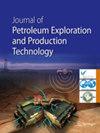Anomaly detection in oil-producing wells: a comparative study of one-class classifiers in a multivariate time series dataset
IF 3.2
4区 工程技术
Q3 ENERGY & FUELS
Journal of Petroleum Exploration and Production Technology
Pub Date : 2023-11-08
DOI:10.1007/s13202-023-01710-6
引用次数: 0
Abstract
Abstract Anomalies in oil-producing wells can have detrimental financial implications, leading to production disruptions and increased maintenance costs. Machine learning techniques offer a promising solution for detecting and preventing such anomalies, minimizing these disruptions and expenses. In this study, we focused on detecting faults in naturally flowing offshore oil and subsea gas-producing wells, utilizing the publicly available 3W dataset comprising multivariate time series data. We conducted a comparison of different anomaly detection methods, specifically one-class classifiers, including Isolation Forest, One-class Support Vector Machine (OCSVM), Local Outlier Factor (LOF), Elliptical Envelope, and Autoencoder with feedforward and LSTM architectures. Our evaluation encompassed two variations: one with feature extraction and the other without, each assessed in both simulated and real data scenarios. Across all scenarios, the LOF classifier consistently outperformed its counterparts. In real instances, the LOF classifier achieved an F1-measure of 87.0% with feature extraction and 85.9% without. In simulated instances, the LOF classifier demonstrated superior performance, attaining F1 measures of 91.5% with feature extraction and 92.0% without. These results show an improvement over the benchmark established by the 3W dataset. Considering the more challenging nature of real data, the inclusion of feature extraction is recommended to improve the effectiveness of anomaly detection in offshore wells. The superior performance of the LOF classifier suggests that the boundaries of normal cases as a single class may be ill-defined, with normal cases better represented by multiple clusters. The statistical analysis conducted further reinforces the reliability and robustness of these findings, instilling confidence in their generalizability to a larger population. The utilization of individual classifiers per instance allows for tailored hyperparameter configurations, accommodating the specific characteristics of each offshore well.

油井异常检测:多变量时间序列数据集中一类分类器的比较研究
采油井的异常会造成不利的经济影响,导致生产中断和维护成本增加。机器学习技术为检测和预防此类异常提供了一个很有前途的解决方案,可以最大限度地减少这些中断和费用。在这项研究中,我们利用公开的3W数据集,包括多变量时间序列数据,专注于检测自然流动的海上油气井和海底气井的故障。我们比较了不同的异常检测方法,特别是一类分类器,包括隔离森林,一类支持向量机(OCSVM),局部离群因子(LOF),椭圆包络,以及前馈和LSTM结构的自编码器。我们的评估包括两种变化:一种是特征提取,另一种是没有,每种都在模拟和真实数据场景中进行评估。在所有场景中,LOF分类器的性能始终优于它的同类。在实际实例中,LOF分类器在有特征提取的情况下达到了87.0%的f1测量值,而没有特征提取的情况下达到了85.9%。在模拟实例中,LOF分类器表现出了卓越的性能,有特征提取的F1度量值为91.5%,没有特征提取的F1度量值为92.0%。这些结果显示比3W数据集建立的基准有所改进。考虑到真实数据更具挑战性,建议加入特征提取以提高海上油井异常检测的有效性。LOF分类器的优越性能表明,作为单个类的正常情况的边界可能定义不清,而正常情况可以通过多个聚类更好地表示。所进行的统计分析进一步加强了这些发现的可靠性和稳健性,使人们相信它们可以推广到更大的人群。每个实例使用单独的分类器可以定制超参数配置,以适应每口海上油井的特定特征。
本文章由计算机程序翻译,如有差异,请以英文原文为准。
求助全文
约1分钟内获得全文
求助全文
来源期刊
CiteScore
5.90
自引率
4.50%
发文量
151
审稿时长
13 weeks
期刊介绍:
The Journal of Petroleum Exploration and Production Technology is an international open access journal that publishes original and review articles as well as book reviews on leading edge studies in the field of petroleum engineering, petroleum geology and exploration geophysics and the implementation of related technologies to the development and management of oil and gas reservoirs from their discovery through their entire production cycle.
Focusing on:
Reservoir characterization and modeling
Unconventional oil and gas reservoirs
Geophysics: Acquisition and near surface
Geophysics Modeling and Imaging
Geophysics: Interpretation
Geophysics: Processing
Production Engineering
Formation Evaluation
Reservoir Management
Petroleum Geology
Enhanced Recovery
Geomechanics
Drilling
Completions
The Journal of Petroleum Exploration and Production Technology is committed to upholding the integrity of the scientific record. As a member of the Committee on Publication Ethics (COPE) the journal will follow the COPE guidelines on how to deal with potential acts of misconduct. Authors should refrain from misrepresenting research results which could damage the trust in the journal and ultimately the entire scientific endeavor. Maintaining integrity of the research and its presentation can be achieved by following the rules of good scientific practice as detailed here: https://www.springer.com/us/editorial-policies

 求助内容:
求助内容: 应助结果提醒方式:
应助结果提醒方式:


